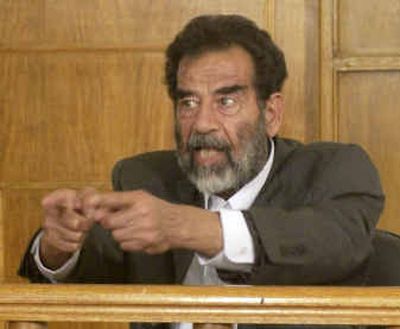Saddam denounces Iraqi court

BAGHDAD, Iraq – A combative Saddam Hussein re-emerged for the world to see Thursday, rejecting an Iraqi judge’s charges of massacres and chemical-gas attacks and denouncing his first day in court as “theater by Bush the criminal.”
Wearing an ill-fitting pinstriped jacket provided by the U.S. military, the man who once lorded over 26 million Iraqis appeared along with 11 of his top aides in a U.S. Army courthouse on the grounds of his former palace on the edge of Baghdad.
The 12 men accused of masterminding 35 years of repression and savagery struck every pose from fear and resignation to defiance and contempt during the 4 1/2 hours of hearings in which they heard the litany of charges against them. In the end, most acquiesced to the process unfolding around them, and of the dozen defendants, only Saddam refused to sign a list of charges until he could see a lawyer.
“I am Saddam Hussein, president of Iraq,” he declared, echoing the words he uttered seven months ago, when U.S. troops plucked him from an underground hiding place on a farm near his hometown.
Akin to arraignments in the West, the hearings raised the curtain on the process by which Iraq will seek to reconcile 35 years of Baath Party tyranny and account for the nation’s darkest chapters. Full trials are not expected until next year, but Thursday’s proceedings – heavily guarded with only a limited audience – publicly revealed the charges against Saddam and his aides and offered Iraqis their first glimpse of once-unthinkable images: men they long feared, now seated before a judge.
The event seemed no less startling to the defendants themselves, once-privileged members of Saddam’s inner circle, now reduced to off-the-rack courtroom clothes and un-dyed hair. Some looked disheveled and confused after months of confinement. Once known for their formidable appetites for liquor, women and brutality, each of them arrived in court invoking God and the sanctity of their legal rights.
The prosecution of Saddam and the others still faces daunting challenges. Documentary and forensic investigations are stalled by violence, while mountains of government documents are scattered across a range of Iraqi political parties and U.S. agencies. Some international human-rights advocates also question whether Iraq has the expertise or the political stability to conduct a fair and credible trial.
This account of courtroom dialogue and scenes is based on video, as well as briefings and translations provided afterward by two journalists from CNN and the New York Times who were selected by the U.S. military to attend.
In a 26-minute appearance, Saddam heard seven preliminary charges against him, recalling some of the most notorious episodes from his nearly 24 years as Iraqi president: chemical-gas attacks on the Kurdish village of Halabja in 1988, the invasion of Kuwait in 1990 and the brutal suppression of a Shiite Muslim uprising the following year. He was also charged with slaughtering the Kurdish Barzani clan in 1983, the 1986-88 effort to displace Kurds, known as the “Anfal campaign,” as well as 30 years of killing the members of political parties.
A formal indictment will be delivered later, said Salem Chalabi, director of the Iraqi Special Tribunal, which was established to investigate and try these cases. Formal charges are expected to include war crimes, genocide and crimes against humanity.
Saddam looked considerably thinner than the hale profile he cut in office, his weight loss accentuated by the oversized white shirt that hung off his neck without a tie. With short dark hair swept back and a trim beard streaked in white, he was a far cry from the wild-maned and thickly bearded figure immortalized on film submitting to a dental exam after his capture last year.
Entering the courtroom, he nervously scanned the simple, five-sided courtroom, and guards seated him in a lone chair, 5 or 6 feet directly across from the judge, whose identity is withheld for his protection.
After declaring his name and his title as president, Saddam seemed genuinely puzzled about the proceeding before chastising the young judge for working “under the orders of the coalition.” The judge, however, retorted that he had been appointed to the bench under Saddam’s regime – a revelation that exposed Saddam’s fundamental confusion over how he could be tried by the nation he once ruled.
“You are using a law that was issued by me to try me,” Saddam said, his voice thin with exasperation. “I am a man who studied the law, and I ask you how you should call upon a president elected by the people and put him on trial by a law he issued himself.”
At other moments, Saddam seemed mystified by his own reputed actions. Of the poison-gas strike on Halabja that killed 5,000 Kurdish villagers, he said: “The talk about Halabja, I used to hear about that on the radio, attacking Halabja under the regime of Saddam Hussein.”
Saddam did not miss an opportunity to taunt his American foes. “You know that this is all a theater by Bush the criminal to help him with his campaign,” he said.
Asked if he could afford a lawyer, he glanced at the panel of American observers and said: “The Americans say I have millions hidden in Switzerland. How can I not have the money to pay for one?”
At the close of his hearing, when the judge produced a document for Saddam to sign, he declined to sign it until he speaks with a lawyer. A court official said later that the refusal to sign will have no bearing on the legal process.
The judge did not set the date of the next hearing, saying it would take place after Saddam has met with his attorneys. Getting up to leave the courtroom, the 67-year-old showed the effects of more than a year either on the run or in jail, saying to two guards at his elbows, “Take it easy. I’m an old man.”